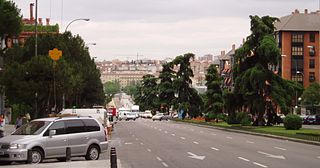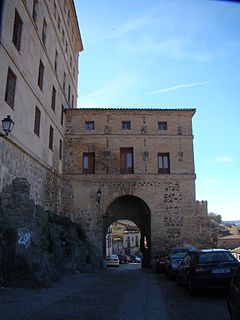
Toledo is a city in and the county seat of Lucas County, Ohio, United States. Toledo is in northwest Ohio, at the western end of Lake Erie bordering the state of Michigan. The city was founded in 1833 on the west bank of the Maumee River, and originally incorporated as part of Monroe County, Michigan Territory. It was re-founded in 1837, after conclusion of the Toledo War, when it was incorporated in Ohio.

Toledo is a city and municipality located in central Spain; it is the capital of the province of Toledo and the autonomous community of Castile–La Mancha. Toledo was declared a World Heritage Site by UNESCO in 1986 for its extensive monumental and cultural heritage.

Baixo Guandu is a municipality located in the Brazilian state of Espírito Santo that was founded on April 10, 1935 and established as a city on June 8, same year. The city's celebration day is April 10. Its population was 29,891 (2009) and its area is 918 km². The area is most well known for its exports of coffee, especially from the high mountains of the district of Alto Mutum Preto. The main watercourse through the municipality is the Rio Doce river whose basin is composed of 222 municipalities.

The Doce River is a river in southeast Brazil with a length of 853 kilometres (530 mi). The river basin is economically important. In 2015 the collapse of a dam released highly contaminated water from mining into the river causing an ecological disaster.

The Gates of Hell is a monumental sculptural group work by French artist Auguste Rodin that depicts a scene from the Inferno, the first section of Dante Alighieri's Divine Comedy. It stands at 6 metres high, 4 metres wide and 1 metre deep (19.7×13.1×3.3 ft) and contains 180 figures. The figures range from 15 centimetres (6 in) high up to more than one metre (3 ft). Several of the figures were also cast independently by Rodin.

The Mosque of Cristo de la Luz is a former mosque in Toledo, Spain. It is the one of the ten that existed in the city during the Moorish period. The edifice was then known as Mezquita Bab-al-Mardum, deriving its name from the city gate Bab al-Mardum. It is located near the Puerta del Sol, in an area of the city once called Medina where wealthy Muslims used to live.

Timóteo is a Brazilian municipality in the state of Minas Gerais, located by the Piracicaba River. The population as of 2016 was 88,255 inhabitants. The city is situated in the metropolitan area of the Steel Valley. It is the hometown of Aperam South America, a steel factory specialized in the production of stainless steel, now named Aperam.

The Puerta de Bisagra is a city gate of Toledo, Spain.

The Puente de Alcántara is a Roman arch bridge in Toledo, Spain, spanning the Tagus River. The word Alcántara comes from Arabic القنطرة (al-qanţarah), which means "bridge".

The Puerta de Toledo is a gate located in Madrid, Spain. It was declared Bien de Interés Cultural in 1996. Construction began in 1812, and was not completed until 1827.

Las Acacias is a ward (barrio) of Madrid belonging to the district of Arganzuela. Its code number is 22 and, as of 2006, its population was of 37,727.
The Walls del Arrabal were the third in a set of five walls built around Madrid, now the capital of Spain. There are no remaining ruins of the Walls del Arrabal, leaving some debate as to their extent and the period of their construction. It is possible that the walls were built as early as the 12th century, however they were most likely constructed in 1438. The walls may have been intended to protect people against the plagues that ravaged the city at the time. The walls united the urbanized suburbs of the city and prevented entry of the infected.
The Walls of Philip II were walls in the city of Madrid that Philip II, in 1566, constructed for fiscal and sanitary control. The walls covered an area of about 125 hectares.

The Puerta de Toledo was one of the twelves city gates that had the Walls of Zaragoza. It was near of San Juan de los Panetes front of the rear of the current Central Market, in the area where were until a few years ago the arches that surrounded the statue of Augustus, in the city of Zaragoza, Aragon (Spain). It took hold on the remains of the Roman walls of Zaragoza.

The Puerta del Cambrón is a gate located in the west sector of the Spanish city of Toledo, in Castile-La Mancha. Also called previously "Gate of the Jews" or "Gate of Saint Leocadia", has been speculated The possibility that the name of the gate, del Cambrón, had its origin in the growth of a thorn bush or plant at the top of the ruins of one of the towers, before the last reconstruction of the gate, In 1576. It has the cataloging of Bien de Interés Cultural.

The City Walls of Toledo are the city walls of Toledo, Castile-La Mancha, Spain. They were made by several civilizations that inhabited Toledo.

The Puerta de Alarcones is a city gate located in the city of Toledo, in Castile-La Mancha, Spain. It is also known by the name of Puerta de Moaguía, as cited in Mozarabic documents of 1216; and Puerta Alta de la Herrería, because it is located at the end of the street where workshops dedicated to ironworks were located.

The Puerta del Vado, is a city gate built between the late-11th and early-12th centuries, is located in the neighborhood of Antequeruela in the city of Toledo,. This district was known before and after the reconquest of the city of Toledo like the arrabal of San Isidoro, an area of important potter tradition.

The Puerta de Alcántara is a city gate located in Toledo, in Castile-La Mancha, Spain. It gives access to the interior of the historic center of the city, passing through its eastern side the surrounding wall. It is in front of the Bridge Puente de Alcántara, that crosses the Tagus river and that in turn is protected by two gates fortified in its ends.

The Massacre of Naarden was an episode of mass murder and looting that took place in the Dutch city of Naarden during the Eighty Years' War. The massacre was committed by Spanish soldiers under the command of Fadrique Álvarez de Toledo against the townspeople of Naarden as part of a punitive expedition against Dutch rebels later known as the Spanish Fury. The city was plundered, women and children were raped systematically and the city was set on fire. The destruction of the city galvanized the Dutch rebels, leading them to continue the Dutch War of Independence against Spain.






















